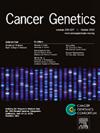PLAU可作为与HNSCC神经周围浸润相关的预后生物标志物
IF 2.1
4区 医学
Q4 GENETICS & HEREDITY
引用次数: 0
摘要
在头颈部鳞状细胞癌(HNSCC)中,神经周围浸润(PNI)是一个独特的临床病理特征,与生存率低相关。为了改善患者的预后,我们的研究深入探讨了PNI在HNSCC,特别是喉癌和下咽癌中的潜在机制。根据癌症基因组图谱(TCGA)的数据,基因根据PNI的存在与否被分为两组。筛选出纤溶酶原激活物尿激酶(PLAU)作为关键分子。接下来,研究人员利用68例HNSCC患者的组织芯片来探索PLAU与神经生长因子(NGF)之间的关系,NGF是PNI的阳性对照。然后,采用共培养模型和细胞损伤功能实验研究PLAU的致癌作用。CCK8和Transwell实验证实了PLAU在促进增殖和转移中的作用。PC12神经突生长试验和共培养系统表明PLAU通过促进PNI影响恶性行为。此外,引入小分子化合物来阻止PLAU和NGF可以有效地恢复体内肿瘤的进展。PLAU通过促进HNSCC中的PNI而促进肿瘤恶性,为阐明PNI的分子机制和确定HNSCC的潜在治疗靶点提供了新的参考。本文章由计算机程序翻译,如有差异,请以英文原文为准。
PLAU serves as a prognostic biomarker correlated with perineural invasion in HNSCC
In head and neck squamous cell carcinoma (HNSCC), perineural invasion (PNI) is a distinctive clinicopathologic feature associated with poor survival. To improve patient prognosis, our investigation delved into the underlying mechanism of PNI in HNSCC, especially laryngeal cancer and hypopharyngeal carcinoma. Based on data from the Cancer Genome Atlas (TCGA), genes were categorized into two groups based on the presence or absence of PNI. Plasminogen activator urokinase (PLAU) was screened out as the key molecular. Next, a tissue microarray comprising 68 patients with HNSCC was used to explore the association between PLAU and nerve growth factor (NGF), a positive control of PNI. Then, the co-culture model and cell damage function experiments were used to investigate the carcinogenic effect of PLAU. CCK8 and Transwell assays confirmed the role of PLAU in promoting proliferation and metastasis. The PC12 neurite growth assay and the co-culture system suggested that PLAU influences malignant behaviors by facilitating PNI. Moreover, introducing small molecule compounds to impede PLAU and NGF can effectively revert tumor progression in vivo. PLAU promotes tumor malignancy by facilitating PNI in HNSCC, offering a novel reference for clarifying the molecular mechanisms underlying PNI and identifying potential therapeutic targets for HNSCC.
求助全文
通过发布文献求助,成功后即可免费获取论文全文。
去求助
来源期刊

Cancer Genetics
ONCOLOGY-GENETICS & HEREDITY
CiteScore
3.20
自引率
5.30%
发文量
167
审稿时长
27 days
期刊介绍:
The aim of Cancer Genetics is to publish high quality scientific papers on the cellular, genetic and molecular aspects of cancer, including cancer predisposition and clinical diagnostic applications. Specific areas of interest include descriptions of new chromosomal, molecular or epigenetic alterations in benign and malignant diseases; novel laboratory approaches for identification and characterization of chromosomal rearrangements or genomic alterations in cancer cells; correlation of genetic changes with pathology and clinical presentation; and the molecular genetics of cancer predisposition. To reach a basic science and clinical multidisciplinary audience, we welcome original full-length articles, reviews, meeting summaries, brief reports, and letters to the editor.
 求助内容:
求助内容: 应助结果提醒方式:
应助结果提醒方式:


